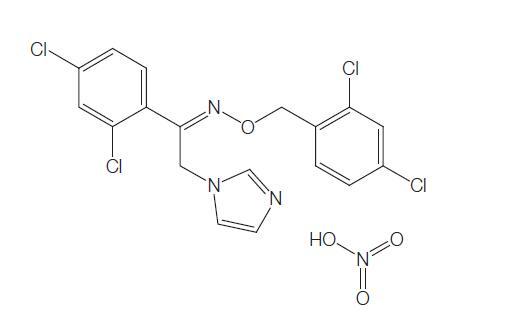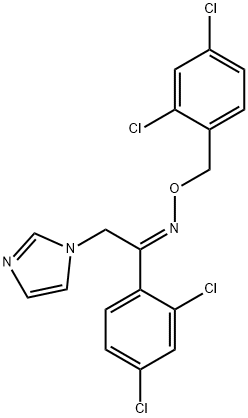Side effects of Oxiconazole
Oxiconazole is a substituted imidazole derivative with the chemical name 2u,4u-dichloro-2-imidazol-1-ylacetophenone(Z)-[O-(2,4-dichlorobenzyl) oxime] nitrate (C18H13Cl4N3O); the chemical structure is shown below. Oxiconazole is structurally distinct from miconazole, econazole, clotrimazole, and ketoconazole because it is an acetophene-oxime derivative. It has a broad spectrum of antifungal activity including activity against yeasts, dermatophytes, and Aspergillus species. Oxiconazole is marketed as a topical formulation for the treatment of superficial dermatophyte infections.

Mechanism of action
The exact mode of action of oxiconazole has not been established, but it is likely to produce its fungistatic and fungicidal activity through inhibition of 14a-demethylation of lanosterol, thereby preventing conversion to ergosterol, which results in depletion of normal fungal sterols (ergosterol) and accumulation of 14a-methylsterols (lanosterol) in the fungal cell membrane. Depletion of ergosterol in the fungal cell membrane results in increased membrane permeability and leakage of essential cellular components. In addition, subinhibitory concentrations of oxiconazole inhibit synthesis of DNA and reduce intracellular concentrations of ATP. Oxiconazole was fungistatic against both early stationary-phase and early logarithmic-phase cells of C. albicans, but did exhibit fungicidal activity against resting phase Candida parapsilosis cells, supporting the notion of direct cell damage.
Dosage
Oxiconazole is available as a 1% oxiconazole nitrate cream. For dermatomycoses such as tinea corporis and tinea cruris the recommended regimen is 1% oxiconazole nitrate cream applied once daily for 2 weeks; for tinea pedis use 1% oxiconazole nitrate cream applied once daily for 4 weeks.
Pharmacokinetics and Pharmacodynamics
There is negligible systemic absorption of oxiconazole following topical application of the drug. In the study by Jegasothy and Pakes, normal volunteers applied 150 mg of 14C-labeled oxiconazole ointment as a single dose. A total of 94.5% of the administered dose was recovered, the majority in the stratum corneum, and 0.3% was recovered from the urine over 5 days. The drug could not be detected in feces, and plasma levels of radioactivity were about 0.3 ng/ml.
The percutaneous absorption of the drug has been evaluated after application of 2.5 mg/cm2 14C -labeled oxiconazole cream to nonabraded skin. Within 5 hours, concentrations of oxiconazole in the epidermis, upper corneum, and lower corneum were 7.96 mg/ml, 1.79 mg/ml, and 0.64 mg/ml, respectively.Inhibitory concentrations of oxiconazole in the epidermis, stratum corneum, and hair follicle persist for at least 16 hours (Jegasothy and Pakes, 1991). Oxiconazole has been compared with amorolfine and bifonazole in the guinea-pig model, and it had the most potent activity at 48 hours after application of the drugs.
Side effects
Less than 2% of patients treated with oxiconazole nitrate 1% cream report adverse events. Itching, burning, erythema, maceration, and fissuring are the most commonly reported side-effects. No significant differences in tolerability have been noted in comparative studies with econazole and bifonazole. Several women have noted intense vaginal burning following application of oxiconazole for the treatment of vaginal candidiasis. Contact allergic dermatitis was reported in 0.4% of patients in oxiconazole clinical trials. The local reactions to oxiconazole are mild and transient and resolve on cessation of the drug.
);

